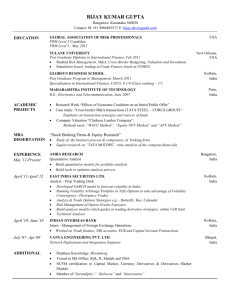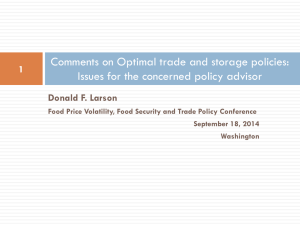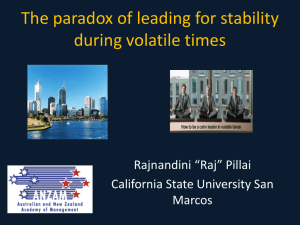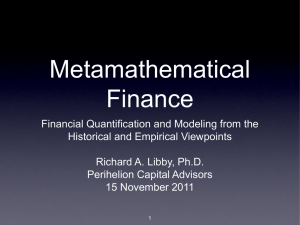The Differential Welfare Effects of Price Levels and Volatility
advertisement
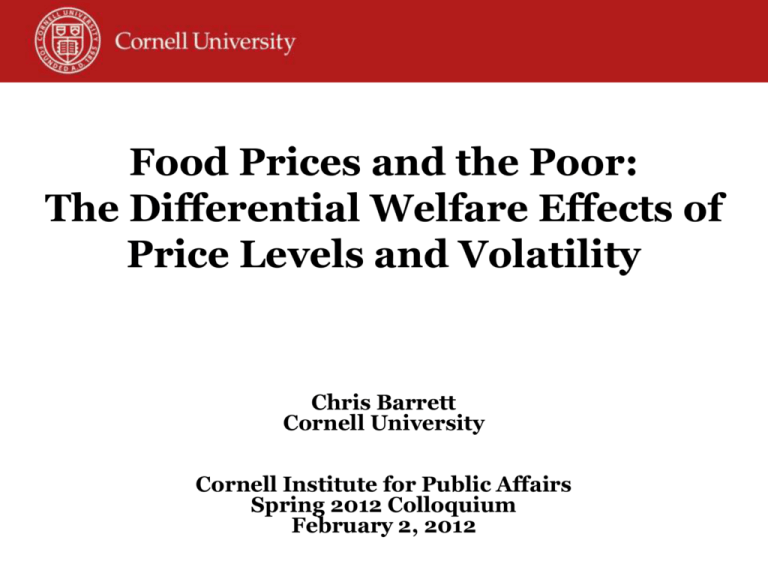
Food Prices and the Poor: The Differential Welfare Effects of Price Levels and Volatility Chris Barrett Cornell University Cornell Institute for Public Affairs Spring 2012 Colloquium February 2, 2012 Factual background Since 2007, real food price levels and variance have risen sharply as compared to the preceding 17 yrs: 2007-11 mean >70% higher vs. 1990-2006, coefficient of variation up >120% 30 25 200 20 150 15 100 10 50 5 0 0 Data source: FAO food price index, 1/1990-10/2011 Lagged 6 mo. (3 mo.) standard deviation of FAO Food Price Index FAO Food Price Index (2002-4 = 100) 250 Causes Why higher, more variable food prices? Confluence of demand and supply side factors: 1) Continued significant demand growth in emerging markets 2) Increasing diversion of food and feed to biofuels production 3) Weather shocks in major growing reasons 4) Financial mkt spillovers/increased commodity speculation 5) Trade policies/gov’t purchases aggravate problems Much dispute as to the weighting among factors Key summary statistic: Stocks-to-use ratios fall and then prices rise and become more volatile … the basic economics of storable commodity prices. Consequences Differentiate between levels and volatility A key error in contemporary policy dialogue: Policymakers and commentators routinely conflate high price levels – a cross-sectional mean – with high food price volatility – a (function of) time series variance – perhaps b/c they naturally correlated by common structural causes. But food price levels and food price volatility have different consequences for different groups. This matters, especially for the political economy of current policy dialogues about the “food price crisis”. Consequences The welfare effects of price levels Well understood: Buyers lose, sellers gain from higher prices Easily reflected in “net benefit ratio” (marketable surplus as proportion of income)= welfare elasticity wrt price (i) Typically increases w/ income in developing countries (ii) Empirical regularity:│NBR<0 │ > │ NBR>0 │. Therefore, food price rises hurt more than symmetric price drops Source: Barrett and Dorosh (1996 AJAE) Consequences The welfare effects of price volatility Well understood: Sellers worse off from price risk (Baron 1970, Sandmo 1971). Less well understood: Welfare effects of price risk are ambiguous for net buyer households (Newbery & Stiglitz 1981, Finkelshtain & Chalfant 1991, Barrett 1996). If most of the poor live in such households, how do volatile food prices affect the poor? Put differently, who favors more stable food prices, poorer net food buyers, better-off net food sellers, or both? Consequences The welfare effects of price volatility Bellemare, Barrett & Just (2011) derive an expression for multivariate price risk aversion and compute the WTP for price stabilization (build on Finkelshtain & Chalfant 1997): Mi ˆ 1 Mi ˆ K WTPi ii [ i (ˆi R) ˆii ] j i ij [ j (ˆ j R) ˆij ] 2 pi pj The sign is ambiguous. For sellers (M, β>0), however, it’s almost surely positive. But what about for buyers and what’s the distributional implication of price risk preferences? Bellemare, Barrett & Just (2011) use panel data from rural Ethiopia to explore that question. Consequences The welfare effects of price volatility Income Percentile Range Sign of Fitted WTP 0.00 - 18.84 0 3.24 - 267.66 18.84 - 49.82 - 267.66 - 441.92 49.82 - 61.49 0 61.49 - 100.00 + Income Range (Birr) 0.00 - 3.24 441.92 - 10,000.00 Result: The best off 40% of hhs favor price food stabilization; the poor (but not very poorest) favor unstable prices. Consequences Summary of welfare effects of high and more variable/volatile food prices If risk effects are second-order compared to levels effects: 1) Price risk averse net buyers unambiguously worse off … but it’s unclear how many such people there are. 2) Price risk loving net buyers are worse off, but greater price volatility limits losses. 3) Net sellers are better off, but more price risk limits gains. Indirect corroboration Resulting political unrest Well understood: High food prices (or resulting policy responses, such as “land grabs”) sow sociopolitical discontent in developing countries: e.g., Haiti, Madagascar 2008; Egypt, Tunisia 2011. Less well understood: Higher food price volatility is negatively associated with political unrest in developing countries once one controls (even instruments) for food price levels, which exert a strong positive effect on political unrest (Barrett and Bellemare 2011; Bellemare 2011). Policy implications Current food price policy dialogue But the push for reducing price volatility, rather than for reducing price levels, implicitly favors better off producers (e.g., in Europe, North America, Australia, Brazil) over poorer consumers globally. Hence Marc Bellemare and my July Foreign Affairs paper: Policy implications Current food price policy dialogue Prices will come down and stabilize naturally if/when/as supply-demand balance restored and food stocks replenish. High opportunity costs, especially for poorer net consumers, if scarce resources (e.g., $, technical skill, political attention and will) devoted to active food price stabilization over: - accelerating supply expansion via productivity growth or - facilitating price stabilization through agricultural trade liberalization and improved physical and institutional infrastructure for food distribution in poor areas. Policy implications Current food price policy dialogue Yet typical (misguided) statements by prominent people include claims such as: French President Sarkozy: “If we don’t do anything [about food price volatility], we run the risk of food riots in the poorest countries.” World Bank President Zoellick: “[Food] prices remain volatile and millions of people around the world are still suffering. The World Bank has been working … to protect the most vulnerable from the dangers of food price volatility.” Homi Kharas, Brookings: “The crux of the food price challenge is about price volatility rather than high prices per se. It is the rapid and unpredictable changes in food prices that wreak havoc on markets, politics, and social stability.” Policy implications Current food price policy dialogue At least three candidate explanations: 1) Genuine confusion over terms. Volatility is a latent concept proxied by a variety of statistical measures about which lay people are typically imperfectly informed. Or just sloppy use of the term to blend levels/variability/range. 2) Conflation of correlation with causality. High food prices harm the poor and cause political unrest. And high food price levels and high price volatility are correlated. 3) Political capture. Powerful farm lobbies are able to use populist language to tilt policies to benefit small, better-off interest groups. Thank you Thank you for your time, interest and comments! Food price inflation protests in Hyderabad, India, Monday, Jan. 10, 2011. AP Photo/Mahesh Kumar A, from businessinsider.com
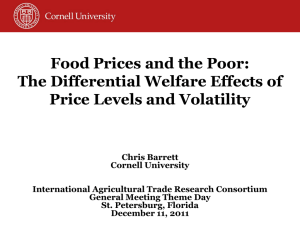


![[These nine clues] are noteworthy not so much because they foretell](http://s3.studylib.net/store/data/007474937_1-e53aa8c533cc905a5dc2eeb5aef2d7bb-300x300.png)


